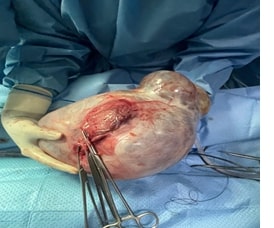An Enormous Benign Mucinous Ovarian Cystadenoma: A Case Study and Literature Review

Abstract:
An ovarian tumor is not a singular entity, but rather
a very wide spectrum of neoplasms spanning a variety of histological tissues [1]. The most common type of tumors, epithelial tumors,
account for 80% of all malignancies.10% of tumors are classified as possibly
malignant, 8%–10% are malignant, and 80% are benign. About 8–10% of epithelial
tumors are mucinous tumors, which can grow to huge sizes and cover the whole
abdominal cavity [2], [3]. We would like to share a case study of a 50-year-old
female patient who had a large benign mucinous cystadenoma. The patient was
unable to receive medical care and had a tumor that was causing her to have
trouble breathing. The tumor reacted amazingly well after surgical resection [4]. After the operation, the patient could resume her
regular life.
References:
[1].
Eble,
J. N., Tavassoli, F. A., Devilee, P., 2003, International Agency for Research
on Cancer, World Health Organization. Pathology and genetics of tumours of the
breast and female genital organs: Tumours of the breast and female genital
organs. Iarc.
[2].
Sonntag,
B., Lellé, R. J., Steinhard, J., Brinkmann, O. A., Hungermann, D., &
Kiesel, L., 2005, Retroperitoneal mucinous adenocarcinoma occuring during
pregnancy in a supernumerary ovary. Journal of Obstetrics and Gynaecology,
25(5), 515–516. https://doi.org/10.1080/01443610500193478.
[3].
Tait,
D. L., Miller, D. S., 1997, Multicystic ovarian tumour weighing 156 pounds
second largest in texas. Tex Med 93:89.
[4].
Sagiv,
Ron M. D., Golan, Abraham M. D., FRCOG; Glezerman, Marek M. D., 2005,
Laparoscopic Management of Extremely Large Ovarian Cysts. Obstetrics &
Gynecology 105(6):p 1319-1322, DOI: 10.1097/01.AOG.0000159690.18634.f0.
[5].
Tjalma
W. A. A., Vaneerdeweg, W., 2008, Primary retroperitoneal mucinous
cystadenocarcinomas are a distinct entity, Int. J. Gynecol. Cancer, vol.
18, no. 1, p. 184, doi: 10.1136/ijgc-00009577-200801000-00032.
[6].
An,
J. Y., Heo, J. S., Noh, J. H., Sohn, T. S., Nam, S. J., Choi, S. H., Joh, J.
W., Kim, S. J., 2007, Primary malignant retroperitoneal tumors: Analysis of a
single institutional experience. European Journal of Surgical Oncology
(EJSO), 33(3), 376-82.
[7].
Crum,
C. P., Lester, S. C., Cotran, R. S., 2007, Pathology of female genital system
and breast. In: by Kumar, V., Abbas, A., Fausto, N., Mitchell, R., eds.
Robbins’ Basic Pathology. 8th ed. USA: Elsevier Company, Chapt. 19.
[8].
de
León, D. C., Pérez-Montiel, D., Chanona-Vilchis, J., Dueñas-González, A., 2007,
Villavicencio-Valencia, V., Zavala-Casas, G., Primary retroperitoneal mucinous
cystadenocarcinoma: Report of two cases, World Journal of Surgical Oncology,
5, 1-6.
[9].
Buy,
J. N., Ghossain, M. A., Sciot, C., Bazot, M., Guinet, C., Prévot, S., Hugol,
D., Laromiguiere, M., Truc, J.B., Poitout, P., 1991, Epithelial tumors of the
ovary: CT findings and correlation with US. Radiology, 178(3), 811-8.
[10]. Poli Neto, O. B.,
Candido Dos Reis, F. J., Zambelli Ramalho, L. N., Nogueira, A. A., de Andrade,
J. M., 2006, p63 expression in epithelial ovarian tumors. Int J Gynecol
Cancer, 16(1), 152-5.
[11]. McCluggage, W. G.,
2011, Morphological subtypes of ovarian carcinoma: A review with emphasis on
new developments and pathogenesis, Pathology, 43, 420–432.
[12]. Baksu, B., Akyol,
A., Davas, I., Yazgan, A., Ozgul, J., Tanık, C., 2006, Recurrent mucinous
cystadenoma in a 20-year-old woman: Was hysterectomy inevitable? Journal of
Obstetrics and Gynaecology Research, 32, 615-618,
https://doi.org/10.1111/j.1447-0756.2006.00453.x.
[13]. Kokawa, K.,
Mikami, Y., Sakata, H., Oki, N., Tanakas, T., Yamazaki, M., Nakata Y, Umesaki,
N., 2009, Clinical outcome and prognostic factors in borderline tumors of the
ovary. Results from 17 years’ experience in the Kinki District of Japan
(1990-2006). Eur. J. Gynaec. Oncol.-ISSN, 392, 2936.
[14]. De Iaco, P.,
Ferrero, A., Rosati, F., et al., 2009, Behaviour of ovarian tumors of low
malignant potential treated with conservative surgery, Eur J Surg Oncol,
35, 643–648.
[15]. Katke, R. D.,
2014, International Journal of Reproduction, Contraception, Obstetrics and
Gynecology, Vol. 2, 459.
[16]. Seidman, J. D.,
Mehrotra, A., 2005, Benign ovarian serous tumors: A re-evaluation and proposed
reclassification of serous ‘cystadenomas’ and ‘cystadenofibromas’. Gynecol
Oncol. 96(2), 395-401.
[17]. Cuatrecasas, M.,
Villanueva, A., Matias-Guiu, X., Prat, J., 1997, K-ras mutations in mucinous
ovarian tumors: A clinicopathologic and molecular study of 95 cases. Cancer,
79(8), 1581-6.
[18]. Lalwani, N.,
Shanbhogue, A. K. P., Vikram, R., Nagar, A., Jagirdar, J., Prasad, S. R., 2010,
Current update on borderline ovarian neoplasms, AJR Am J Roentgenol,
194, 330–336.
[19]. Howard, W.,
Epithelial ovarian cancer. In: Jones, Anne Colston Wentz, Lonnie S. Burnett,
eds. Novak’s Textbook of Gynaecology. 11th ed. UK, 1, Williams & Wilkins
988: 806-809.
[20]. Wilfred Shaw, John
Howkins, Gordon Lionel Bourne. Disorders of the ovary and benign tumours. In:
Wilfred Shaw, John Howkins, Gordon Lionel Bourne, eds. Shaw’s Textbook, 14th
ed. London: Churchill Livingstone; 2008: 334.

